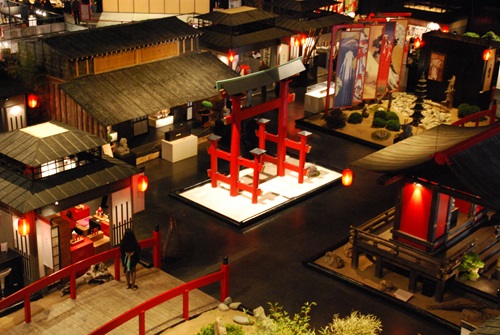Tokyo (SCCIJ) – When “muba” fair opens its doors for the last time at Messe Basel from 8 to 17 February, a touch of exoticism will be a must. This year’s host country, Japan, with its centuries-old traditions, is taking care of this. The special exhibition about the Land of the Rising Sun transports visitors to a fascinating culture full of aesthetics. The participation of Japan is also an expression of the internationalism that has characterized the “muba”. Muba is the abbreviation of “Mustermesse Basel” which literally translates to “samples fair”. The original meaning points to the fact that samples of a product are shown at a fair to visitors and wholesale buyers.
A country with a moving history
The exhibition of the host country at “muba” is an invitation to take a stroll through a versatile country with a multi-faceted cultural heritage. It illuminates various aspects of the aesthetics so important in Japan, for example in horticulture, architecture or art.
Visitors find themselves in a quarter of the imperial city of Kyoto, which was the capital of Japan until the middle of the 19th century. The houses are inspired by woodblock prints and paintings of the artist Hiroshige.

A vision of Japan's booths at muba 2019
In the first pavilion, visitors can immerse themselves in the moving history of the country. There are also two niō (guardian figures), which are usually found at the entrances of temples. The exhibition also houses one such temple, including a Buddha statue made of lava stone.
The land of cherry blossoms also has a lot to offer on the theme of nature. Numerous panels, which were compiled by scientists, explain the geophysics of Japan. The exposed volcanic rock comes from Japanese volcanoes. Various gardens allow visitors to immerse themselves in the planned naturalness of the famous Japanese garden design. This is an important element, as plants are associated with something sacred and divine in Japan. The highlight is a unique bonsai exhibition with some specimens that are already over 100 years old. For those interested there is also a small sales stand.
Tea art, kimono and sushi
A pavilion tells the moving story of the samurai, including the dark times of the ultranationalists. Another one shows rare furniture, one is dedicated to the art of kokeshi dolls, one to tea art. There you will find utensils of the traditional tea ceremony, which is firmly anchored in everyday life. Of course, tasting is also permitted. Not to forget the precious kimono made of silk embroidered with gold and silver threads. They can also be bought.
The last exhibition area of the host country is dedicated to the world of manga. It is explained by panels and reflects the Japanese zeitgeist. And what else should not be missing? A sushi bar, of course. A team specially arrived from the Land of the Rising Sun not only conjures up the Japanese national dish, but prepares and serves also other local delicacies and fine cocktails.
Last Basel "muba"
The Mustermesse Basel (“muba” for short) is an annual trade fair event held in the Swiss city of Basel since 1917. Both the name and the abbreviation are often used in colloquial language for the exhibition grounds, although fairs other than “muba” also take place there (e.g. Baselworld). At Hall 2 (architect Hans Hofmann), a large clock adorns the glass façade, which has become the landmark of the fair – a similar building is located in the Birsfelden power station. Since 2003, the Messeturm has risen up on the Messeplatz, making it the second landmark of the fair.
The exhibition grounds of Messe Basel comprise an exhibition area of 132,000 m² spread over five halls around the exhibition site, a congress centre with 16 congress and conference rooms, a musical theatre with 1500 seats and a multi-storey car park with over 1000 seats.
The “muba” occupies all three floors of Hall 2 and the first floor of Hall 1. It attracts over 300,000 visitors from Switzerland, southern Germany and France every year, making it the second-largest public fair in Switzerland after the OLMA and ahead of the BEA. Overall, visitor numbers have declined, though. Thus, this year’s “muba” will be the last after 102 years.
Text source: Muba.ch, translated and edited by SCCIJ; Photo: Muba.ch





























